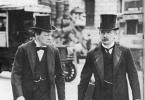One of my friends, while surfing the Internet, came across a site with eternal questions, such as why ice is slippery. There was also a mini-article with reference to an original study on why the bike moves. It turns out that big guys from science, distracted from elementary particles and sacred nanophysics, devote time to this issue. They created a bicycle model free from the two biggest "helpers" of a cyclist: the gyroscopic effect and the tilt of the front wheel fork (castor) ... and even this model turned out to be stable!
What is sustainability and why is it needed?
A cyclist on a stationary bicycle is initially in a state of unstable equilibrium. Any disturbance will lead to an exit from the unstable equilibrium - in our case to the earth, where he will remain as long as he wants. Below are examples of unstable and stable equilibria. 
But everything changes when the bike is moving. In this case, if the bicycle wants to fall, its front wheel is rotated to restore its vertical position. Moreover, this return is built into the very physics of the bicycle, so the rider, in fact, does not need to do anything. A bicycle accelerated to a certain speed (the article gives a value of 15-20 km/h) can ride in a stable vertical position without a cyclist.
Due to the fact that the bicycle is stable only in motion, but not at rest, we can say that this system is dynamically stable.
What helps the bike return to its original position?
The two effects that contribute the most are the gyroscopic effect and the front wheel caster.
The gyroscopic effect is an effect that occurs in rotating systems that have a certain angular momentum when they try to change the direction of the axis of rotation. The force arising in this case is called gyroscopic force. The gyroscopic effect is not trivial to explain, but it is easy to feel. The simplest experiment that each of you can do at home is to take a bicycle wheel by the axle, spin it and try to wave it in the air. You will feel powerful. Moreover, the more you spin the wheel, the greater the force. Powerball training is based on the same strength, only the system is a little more optimized. When you tilt the bike, the front wheel axle also tilts, and the wheel turns in the direction of the tilt due to the gyroscopic effect.
Castor in our literature is the angle of inclination of the car's turning axis. There it is: caster effect, castor, etc. Our steering angle is the same castor. 
The existence of castor causes the front wheel contact point to be beyond the imaginary intersection of the fork line and the ground. This leads to the so-called “footprint” or trail of the front wheel. You can observe the effect of this geometry on trolleys in Auchan stores: the wheel always tends to drag behind the trolley. During stabilization, this manifests itself in the fact that when the bicycle is tilted, the front wheel tends to “fall” towards the tilt of the bicycle, thereby turning the wheel to the side
What if?..
What if you remove these two effects? J. D. G. Kooijman, J. P. Meijaard, Jim M. Papadopoulos, Andy Ruina, and A. L. Schwab assembled a bicycle model in which both effects are absent—two-mass-skate (TMS). 
They greatly reduced the wheel footprint and flipped it backwards, made the wheels smaller and added secondary wheels that spin the other way to eliminate the gyroscopic effect. 
And as you can see from the video, the model still turns out to be stable!
But the conclusions are quite vague. First, if castor and the gyroscopic effect are excluded, then the forces that can stabilize a bicycle must arise from the interaction of the wheel with the surface during movement. Secondly, although castor and the gyroscopic effect are not necessary, they cannot be considered in isolation, because according to the authors, it is possible to build systems that, in the presence of only one of the effects, will turn out to be unstable at any speeds accessible to humans. That is, the interaction of these two effects is important for stability. This means that there are no universal schemes for all types of bikes, which leaves a lot of room for manufacturers and marketing.
PS. When I was researching this article, I came across an extensive one on EnWiki about bicycle and motorcycle dynamics, about what forces influence the movement of a bike, about different effects, geometries, etc. with the number of links > 50. If desired, I can retell it in parts here.
What prevents us from riding a bike: 10 most common reasons
What prevents us from riding a bike: 10 most common reasons
If you ask random passers-by whether they like to ride a bike, in most cases you will get a positive answer. However, if you change the question a little and ask whether these people ride a bicycle, then more than 80% will answer that they do not, for one reason or another. It turns out to be a paradox: people love to ride, but don’t do it.
However, before we begin, it is worth making a small disclaimer. So to speak, process a possible objection. It may seem to you that the entire list can be contained in two words: laziness and lack of time. And all the excuses that we heard during surveys are simply a consequence of these two factors. However, even laziness and lack of time have their prerequisites, which we want to pay special attention to in this article.
Reason #1: fatigue
Work squeezes out all the juices. In the evening I only have enough energy to come home, have dinner, take a shower and go to bed. As a last resort, go to the cinema or sit with friends in a cafe. Relax. Of course, a bicycle is great, but you don’t have the strength to pedal and go somewhere. Yes, and desires too. Common situation?
But if you look from the other side. Nobody forces you to set speed records or conquer off-road terrain. After all, in the end, nothing prevents you from getting together with friends and just relaxing during a bike ride. Many people have a problem: taking the first step - packing up and leaving. However, imagine that you met with friends, and suddenly each of you had a bicycle. What prevents you from going here and now? That's right, nothing. And even fatigue doesn’t interfere. Therefore, the reason is more likely organizational than physical fatigue.
In addition, slow cycling is more relaxing than a soft bed, as we actively breathe fresh air, enriching the body with oxygen.
Reason #2: workaholism
Another reason related to work, and especially relevant for residents of megacities. Remember, has this ever happened to you: it seems like you’ll sit for another hour or two, hand in the project, and then you can go for a ride. However, time passes... An hour turns into three. Where there are three, there are six. And then fatigue, burnout and you don’t want anything anymore.
But meanwhile, a break for a bike ride significantly speeds up your metabolism and thought processes, refreshes your ideas and allows you to look at many things differently.
Reason #3: bad weather
Yes, the weather is definitely holding us back. However, this applies equally to any outdoor activity. Grilling barbecue and singing songs with a guitar in the pouring rain is also below average pleasure. Or is it not? How many Russians, out of almost 150 million people, do you think never eat barbecue outdoors because the weather is bad?
Another thing is that many people simply don’t want to get dirty or cold again. As soon as you think that you need to get a bike. And for this you need to dismantle the floor of the balcony. Then after the trip, wash it and put it back. The desire to ride melts before our eyes. Then you catch yourself thinking: if only he stood ready at the entrance...
Just for those who don’t want to think about storing an “iron horse,” city rental is perfect if the bike station is located close to home. This option is ideal if you don’t have your own bike.
Reason #4: bored alone, no company
Social factors stop millions of people from cycling every day. And it’s not even that there are no friends. There are still friends. But most of them are very busy. Everyone has a job and family. It's hard to break out of routine.
But meanwhile, this problem can be solved very simply. Join a cycling club or register on a cycling forum, and you will always have people who want to keep you company.
Reason #5: no place to ride
Another pressing problem for megacities. Many residents of big cities would like to ride, but driving among cars and breathing exhaust fumes is a very dubious pleasure.
There is a service to solve this problem. You will be surprised, but even if you live in a crowded metropolis, you are surrounded by dozens and hundreds of exciting cycling routes that pass through historical centers and forested areas.
Reason #6: technical malfunction
Many people, when their bike breaks down for any reason, be it a puncture of the wheel or a malfunction of the attachment, put off repairs. “Sometime later, right now there’s no time to do this.” And so this “then” wanders, first from day to day, then from week to week, then from month to month. A person loses the habit of cycling, and it becomes more and more difficult to return to cycling again.
Meanwhile, there are many specialized workshops around that not only repair, but also regularly service bicycles. Bring your “iron horse” to them, and they will do the rest without your participation and with minimal time investment.
Reason #7: lack of infrastructure
There are people who say that they would ride more if we had a better developed cycling infrastructure. “In Europe,” they say, “there are many more good bike paths, which is why there are so many cyclists.” And this is a big misconception. Any city grows where people live, and not vice versa. It has never happened before that a metropolis was built in a remote place, and then it was populated. So the infrastructure for cyclists is better where there are more of them.
Look at Copenhagen. This city is deservedly recognized as a leader in the development of cycling infrastructure. This is what it looks like these days:

And this is what it looked like in the 1930s:

In those years, the Danes had not yet thought about separate bicycle paths, but a certain number of cyclists on the streets, as you can see, could already be noticed. Look carefully, in the second photo there is a car crawling right in their crowd. It turns out that motorists in Copenhagen were fighting for separate lanes to escape cyclists. It is naive to expect the authorities to provide infrastructure like in Denmark if we ourselves do not constantly use bicycles as transport.
Reason #8: Security
Many people avoid riding bicycles in the city for safety reasons. And here we need to clarify one important point. You've probably seen more than once reports of accidents involving cyclists or reports of injuries during bicycle parades.
In 90% of cases, such accidents occur due to non-compliance with safety rules by cyclists themselves. For example, even the traffic rules clearly state that you cannot cross the roadway on a bicycle, you must dismount. And the reason here is very simple: the driver of a turning car may not notice the cyclist from behind the stand, because speeds are comparable. But if you dismount, the risk of an accident decreases significantly.
Reason #9: myths and prejudices
Many people are afraid to ride a bike because they believe that cyclists are more prone to a number of diseases. First of all, these are joint injuries, which can lead to almost disability.
Indeed, the joints are subject to increased stress, but injury can be easily avoided if you drink fluids on time over long distances and maintain the correct cadence and pedal speed (about 60-80 rpm).
Moreover, if we follow the logic of prejudice, then sedentary work and a sedentary lifestyle also create a risk of disease, and on a much wider spectrum.
Reason #10: monotony and monotony
Many people stop riding bicycles simply because they get bored. Same routes, driving alone, too much time spent planning new routes, etc.
To solve this problem, you should also use the service. With it, new routes open up in front of you every day and new people appear with whom you can go on a bike ride.
Conclusion
As you can see, there are many reasons and explanations for why people don’t ride. But if you think about it, none of them is a serious and intractable problem.
A bike ride can give you positivity, a boost of vivacity, energy and new ideas. Just grab your bike and hit the road. And MnogoTrop and I will help you easily find a new interesting place for this.
Have fun!
Try sitting on a stationary bike and then lifting both legs off the ground! You won't be able to keep your legs suspended for three seconds! But once you try to ride, your bike will immediately turn into a very stable means of transportation.
It turns out that during movement, forces appear that keep the bicycle in balance. What kind of forces are these?
Version one
The bike is kept from falling by the gyroscopic effect that occurs when the wheels rotate. The same effect, by the way, prevents a rotating top from falling.
As for the top, let's turn it into a bicycle wheel. To do this, place the wheel removed from the bicycle horizontally, placing the axle on a hard surface. In order to make the wheel stand on its axis, like a top, the wheel will have to be spun very strongly. But you can ride a bicycle without falling, even when its wheels rotate much slower!
Version two
The bicycle does not fall because the cyclist is steering it. As soon as the bicycle begins to fall, the cyclist will immediately, involuntarily turn the steering wheel in the direction where it is falling. The bicycle begins to turn, and the resulting centrifugal force levels it out, preventing it from falling.
Well, the version is not bad! After all, learning to ride a two-wheeled bicycle consists of learning to turn the steering wheel to the desired angle. But why then don’t those who know how to ride “without a steering wheel”, that is, without holding onto the steering wheel, fall?
Version three
If the wheel is tilted, it will not roll in a straight line, but in a circle, the center of which is in the same direction as the wheel is tilted. As the bike falls, it tilts, which means the wheels tilt along with it. A tilted bicycle turns and centrifugal force tends to compensate for the fall - just as explained in the previous version.
With the tilted wheel everything is correct. But according to this version, the alignment of the bicycle occurs by itself, which means that the less you interfere with the process, the better. Let's reduce your participation to a minimum, depriving you of the ability to steer, for this we will tightly weld the front fork of the bicycle to the frame. How far will you go?
Version four
It's all about the design of the bike. Let's tilt the bike while holding it by the saddle. We will see that the front fork will automatically rotate towards the lean side. This means that as soon as the bicycle begins to fall, its front wheel will begin to turn itself in the direction of the fall. Well, then the same centrifugal force comes into play.
This option would be quite suitable for explaining how it is possible to control a bicycle when riding “without hands”! Maybe then you don’t need either a steering wheel or the ability to drive? But why then does the bicycle fall if no one is sitting on it, when, for example, you push an empty bicycle down a hill?
It turns out that none of the proposed versions is completely suitable? But the cyclist, nevertheless, does not fall! How do you think why?
We have presented four versions as possible answers, although for each version one can find considerations that cast doubt on its correctness.
It is believed that two mechanisms play a critical role in maintaining the balance of a bicycle. The first is automatic steering: if the bike leans in one direction, the front wheel automatically turns in the same direction; the entire bicycle begins to turn, and the centrifugal force returns the wheel to its original position. It also returns when driving in a straight line, after an accidental deviation to the side. Such steering is associated with the design of the front fork, the axis of rotation of the steering wheel: if you mentally continue it down, it will intersect with the surface of the earth before the point at which the wheel itself touches it - an angle (caster) appears between them, which has a stabilizing effect and when directed in side of forces, the wheel tends to return to its original position. The second mechanism is associated with the gyroscopic moment of the rotating wheels.
Everything is quite simple - however, American engineer Andy Ruina and his colleagues set out to refute both statements. They designed a bicycle in which the effects of both mechanisms are neutralized. Unlike all “real” bicycles, this one has the front wheel touching the support before the point where the front fork axis intersects it, which “cancels” the action of the castor. And in addition, both the front and rear wheels are connected to two others, rotating in the opposite direction and thereby nullifying the gyroscopic effect.
Of course, outwardly this whole machine is more reminiscent of some kind of custom bike (read about them: “Slowly”) or even a scooter, rather than a traditional bicycle: the wheels are small, there is no saddle... But nevertheless, structurally it’s still , a bike you can experiment with. Take it and push it - and see how quickly it falls on its side! Surprisingly, not so fast; in fact, it maintains balance no worse than a regular bicycle, it even demonstrates the same automatic steering.
Based on the results of the experiment, the authors draw an unambiguous conclusion: both effects - the castor and the gyroscope - play an important role in maintaining the balance of a riding bicycle, but both of them are not critical for it. Note that bicycle designs without a gyroscopic moment have already been tested previously, but the refutation of the most important role of castor in maintaining the balance of the bicycle has been done for the first time, and very clearly.
So why doesn't the bike fall? Apparently, the special load distribution plays a key role in this: the center of mass in the front part is located significantly lower than in the rear. As a result, the front wheel falls faster than the rear, and since they are rigidly connected along the vertical axis, the front wheel, instead of simply tilting to one side, turns in the same direction, straightening the position of the bicycle.
It is believed that two mechanisms play a critical role in maintaining the balance of a bicycle. The first is automatic steering: if the bike leans in one direction, the front wheel automatically turns in the same direction; the entire bicycle begins to turn, and the centrifugal force returns the wheel to its original position. It also returns when driving in a straight line, after an accidental deviation to the side. Such steering is associated with the design of the front fork, the axis of rotation of the steering wheel: if you mentally continue it down, it will intersect with the surface of the earth before the point at which the wheel itself touches it - an angle (caster) appears between them, which has a stabilizing effect and when directed in side of forces, the wheel tends to return to its original position. The second mechanism is associated with the gyroscopic moment of the rotating wheels.
Everything is quite simple - however, American engineer Andy Ruina and his colleagues set out to refute both statements. They designed a bicycle in which the effects of both mechanisms are neutralized. Unlike all “real” bicycles, this one has the front wheel touching the support before the point where the front fork axis intersects it, which “cancels” the action of the castor. And in addition, both the front and rear wheels are connected to two others, rotating in the opposite direction and thereby nullifying the gyroscopic effect.
Of course, outwardly this whole machine is more reminiscent of some kind of custom bike (read about them: “Slowly”) or even a scooter, rather than a traditional bicycle: the wheels are small, there is no saddle... But nevertheless, structurally it is still , a bike you can experiment with. Take it and push it - and see how quickly it falls on its side! Surprisingly, not so fast; in fact, it maintains balance no worse than a regular bicycle, it even demonstrates the same automatic steering.
Based on the results of the experiment, the authors draw an unambiguous conclusion: both effects - the castor and the gyroscope - play an important role in maintaining the balance of a riding bicycle, but both of them are not critical for it. Note that bicycle designs without a gyroscopic moment have already been tested previously, but the refutation of the most important role of castor in maintaining the balance of the bicycle has been done for the first time, and very clearly.
So why doesn't the bike fall? Apparently, the special load distribution plays a key role in this: the center of mass in the front part is located significantly lower than in the rear. As a result, the front wheel falls faster than the rear, and since they are rigidly connected along the vertical axis, the front wheel, instead of simply tilting to one side, turns in the same direction, straightening the position of the bicycle.



